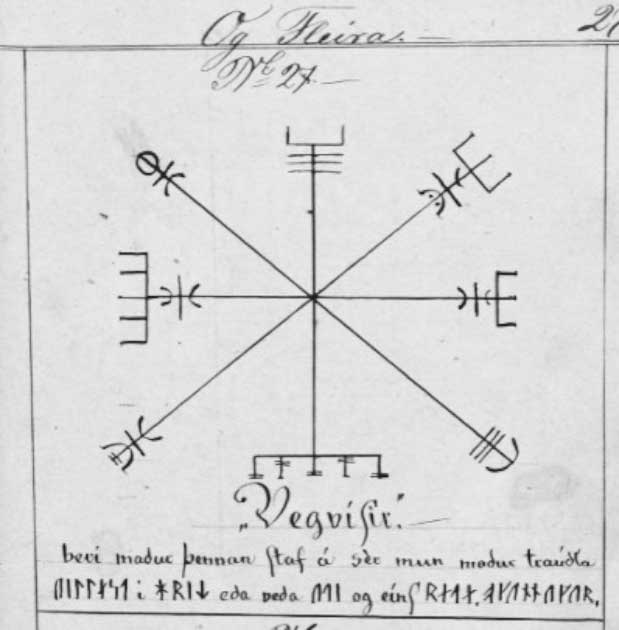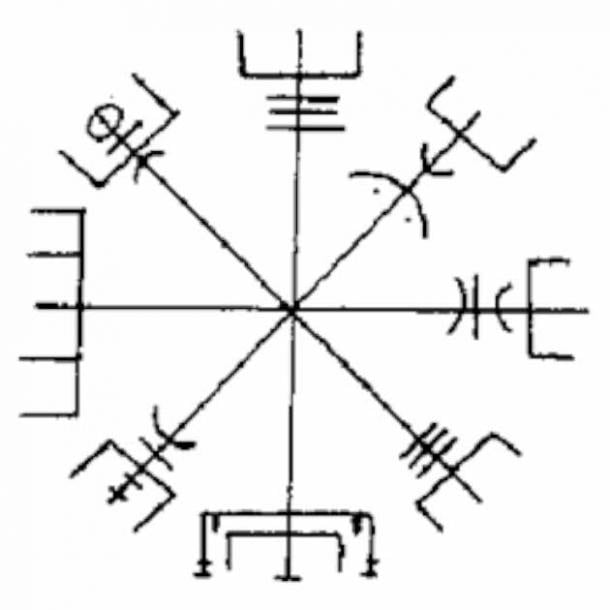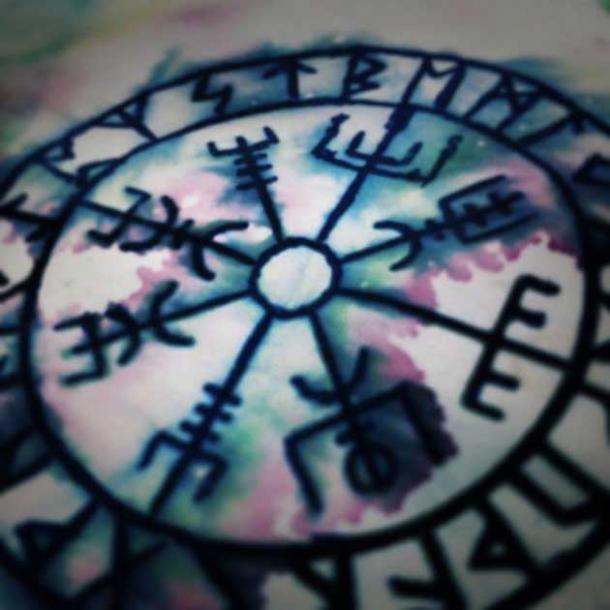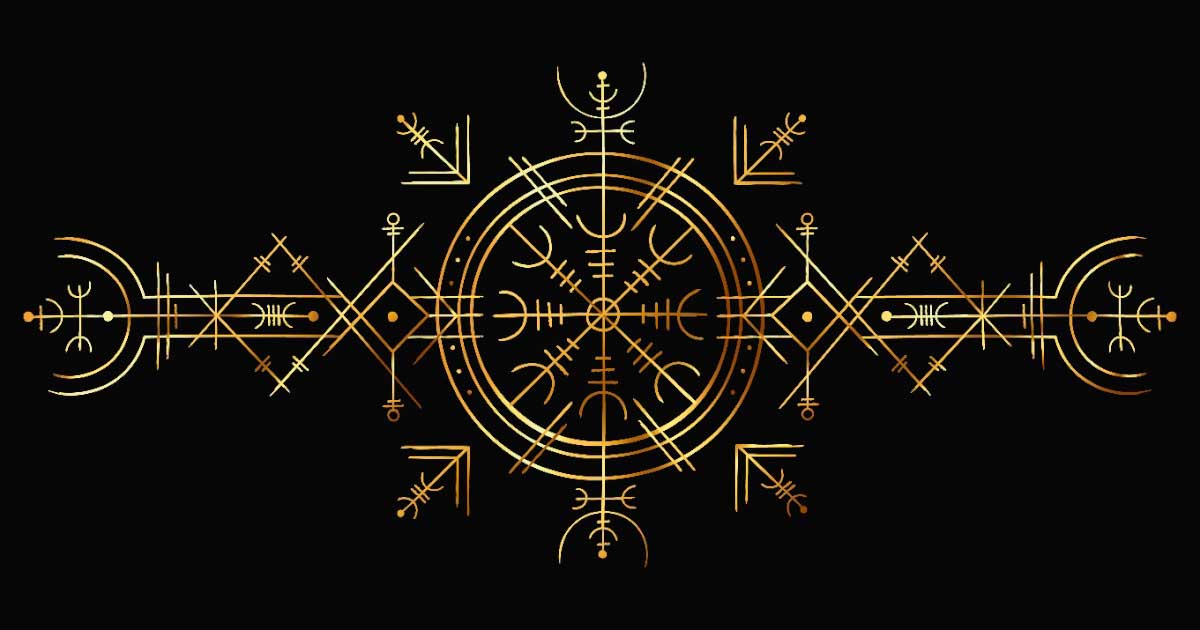Vegvisir: Was the ‘Viking Compass’ Originally a Christian Symbol?
Although the name Vegvisir may not be familiar to you, you may have seen its symbolic representation before. This emblem has gained iconic status largely due to its frequent use in the media. Additionally, it has become popular among neo-pagans, who often wear it as a pendant or get it tattooed on their bodies. Nowadays, Vegvisir is widely acknowledged as an ancient Germanic and Viking runic symbol that functioned as a compass for Viking warriors during their seafaring journeys, offering them divine guidance and protection.
Vegvisir in Christian Mysticism
According to researcher Tomáš Vlasatý, in his article ‘Origins of the “vegvísir” symbol,’ Vegvisir, as well as many other symbols found in Icelandic grimoires, were probably imported to Iceland from England. The origins of many star-shaped symbols can be traced back to England as early as the 15th century, with examples found in texts like the Testament of Solomon. So although Vegvisir is generally viewed as a Viking symbol, it has its earliest roots in Christian mysticism, rather than Norse paganism.
The Huld Manuscript
the 19 th century, the Vegvisir symbol was appearing in Icelandic grimoires, which are textbooks that provide instruction on magical spells, rituals, and tools, as well as guidance on how to create and use them. The symbol is known to be present in three grimoires, the first and most important of which is the Huld manuscript. It was composed in 1860 by Geir Vigfússon in Akureyri, Iceland. This manuscript is made up of 27 paper lists and features a collection of 30 symbols believed to have magical properties. Vegvisir is one of the symbols depicted in the manuscript, appearing on page 60 alongside another unidentified symbol. The accompanying note suggests that carrying the Vegvisir symbol provides protection against getting lost in unfamiliar surroundings, even in the midst of storms or bad weather.
- Decoding Viking Signs: Nine Norse Symbols Explained
- Spells, Invocations, and Divination: The Ancient History of Magical Grimoires

The 1860 Huld manuscript is the earliest mention of the Vegvisir in Icelandic literature (Jara Lisa / CC BY-SA 4.0)
The Book of Spells Manuscripts
The second grimoire, referred to as the Book of Spells or Galdrakver in Icelandic, was authored by Olgeir Geirsson in Akureyri between 1868 and 1869. This manuscript contains 58 pages and displays Vegvisir as symbol 27 on page 27. It comes with a note written partially in Latin and partially in runes which carries the same message as the Huld manuscript, suggesting that carrying the Vegvisir symbol provides protection against getting lost in storms or bad weather.
- Christian Symbols Hidden in Ancient Pagan Mosaics of Butrint Baptistery
- New study reveals Vikings could navigate after dark using sun-compass and mythical sunstone

The Vegvisir is shown on page 27 of Olgeir Geirsson's Galdrakver manuscript (Jara Lisa / CC BY SA 4.0)
The third grimoire, also named the Book of Spells, was created in the Eyjafjord area near Akureyri in the 19th century. Although the author, date, and location of its origin remain unknown, it is a 32-page manuscript that includes many of the same symbols found in the previous two grimoires, such as "Solomon's Sigil" and "Mark against a Thief." Notably, the text accompanying the Vegvisir symbol in this grimoire is overtly Christian in nature. The meaning is somewhat challenging to translate, but it suggests that to avoid getting lost, one should keep the Vegvísir sign under their left arm and believe in it and in God. The text further implies that the meaning of the sign is hidden in these words so that one may not perish and ends with a prayer for luck and blessings from God in the name of Jesus.
The Popularization of Vegvisir
The Vegvisir symbol gained popularity over time, particularly in the 20th century, thanks to several Icelandic works. The first of these was an article by Ólaf Davíðsson in 1903 on Icelandic magical marks and books. The Vegvisir symbol appeared again in a book by Jochum Eggertsson in 1940, entitled The Sorcerer's Screed: The Icelandic Book of Magic Spells, which focused on the same topic. Lastly, in the late 1980s, the author Stephen Flowers mentioned the Vegvisir as a side note on Icelandic grimoires in his paper titled The Galdrabók: An Icelandic Grimoire. However, this paper is likely the main reason for the current popularity of the Vegvisir symbol.

Vegvisir from The Galdrabók by Steven Flowers (Jara Lisa / CC BY SA 4.0)
How Vegvisir became a ‘Viking’ symbol
During the early days of the internet, when there was a growing interest in Norse culture and a new reenactment community was emerging, Flowers' paper was heavily promoted. As one of the few resources on the topic available online, people who were researching the subject inevitably stumbled upon it. Eventually, as the paper gained popularity, online shops that catered to this specific market started using the Vegvisir symbol on their products. Even Icelandic tourist shops started featuring the Vegvisir symbol, promoting it as an authentic Viking symbol.
In 1982, Björk, an Icelandic singer, had the Vegvisir symbol tattooed on her arm, describing it as an ancient Viking emblem that seafarers used to mark their foreheads with coal to navigate. As a result, the Vegvisir symbol became a prevalent tattoo design and a popular addition to the portfolios of tattoo artists. By that time, the symbol had already achieved mainstream popularity.

Icelandic singer Björk, performing at Coachella in 2007. Her arm tattoo of Vegvisir in 1982 helped boost its popularity as a supposed Viking symbol. (thetripwirenyc / CC BY 2.0)
Ultimately, Vegvisir cannot reasonably be considered a Viking symbol, given that its earliest appearance in Nordic sources is some 800 years after the end of the Viking Age. Even the Vegvisir symbols found in the 19th-century Icelandic grimoires are not identical to the symbol we know today. The original symbol was square in shape. It was not until the 20th-century texts from Davíðsson, Eggertson, and Flowers were published that the symbol evolved into the circular one we know today.

Modern tattoos of Vegvisir are generally a circular design (Eddie Black / CC BY 2.0)
Top image: Is thinking of the Vegvisir as a ‘Viking compass’ completely off course? Source: Tartila / Adobe Stock
By Mark Brophy
References
McCoy, D. The Vegvísir. Norse-Mythology. Available at: https://norse-mythology.org/vegvisir/
Scott, J. June 26, 2022. Vegvísir: The truth of the ‘Viking Compass’. Life in Norway. Available at: https://www.lifeinnorway.net/vegvisir-viking-compass/
Vlasaty, T. April 5, 2019. Origins of the ‘Vegvísir’ symbol. Project Forlǫg. Available at: https://sagy.vikingove.cz/en/origins-of-the-vegvisir-symbol/


















Comments
Vegvisir could be consider as a spiritual compass, but much earlier Vikings used the sunstone as a real direction finding instrument, although it was used to find the position of the sun in cloudy condition, and not to indicate magnetic north.
Hi All,
Okay, there's a slight chance one keeps digging that symbol could be seen elsewhere in The Ancient World of our Ancestors all honesty I'd search in the Cast Out Book's from The Original Bible.
In Book 2 of Enoch 2 The Prophet of Old mention's specific names of places in God's Country in Hebrew, oh and let me not forget The Days of The Week.
Sunday
Monday
Tuesday
Wednesday
Thursday
Friday
Saturday
Are recounted in Hebrew.
I'll share the name's next time around from Enoch 2 The Book of The Secret's of Enoch however, I do find it quite intriguing that Enoch 2 was found in Scandinavia aren't They Viking's?
In Jubilees said to be written by Moses probably during the 40 years of wandering in The Desert.
The Narrative of Creation itself relayed too People (Adam in Hebrew means People), by An Angel before The Throne of God that Time was measured by Jubilees and this familiar footnote A.M. Jubilees and then A.M. I've got know idea what that translates too.
As for the Viking Symbol possibly being Christian in Origin one might try researching for Symbols that could match with the Viking's symbol if not there yet elsewhere in The Ancient World.
Are search in Scandinavia possibly. That symbol is going to be seen somewhere.
Oh hey I just had another idea come to me um, a family member not me had to do a Report about a everyday ordinary person The assignment was for and Multiculturalism Class.
The individual interviewed talked about their Family affiliated with The Church associated with The Salvation Army; the other topic about this person and their Family Their Family Crest.
I'm saying it's possible this could be a specific Family Crest and again possibly that Crest maybe in other places from The Ancient World. So perhaps we could start with Sumeria, and go from there.
This is all i wish too share on this Subject pertaining to The Viking Symbol being Christian in Origin, I know Abraham came before Christianity was properly established thus first organized Faith being Judaism ✡.
So until next discussion regarding another exciting subject or topic that's introduced Everyone Goodbye!
Hi All,
Okay, there's a slight chance one keeps digging that symbol could be seen elsewhere in The Ancient World of our Ancestors all honesty I'd search in the Cast Out Book's from The Original Bible.
In Book 2 of Enoch 2 The Prophet of Old mention's specific names of places in God's Country in Hebrew, oh and let me not forget The Days of The Week.
Sunday
Monday
Tuesday
Wednesday
Thursday
Friday
Saturday
Are recounted in Hebrew.
I'll share the name's next time around from Enoch 2 The Book of The Secret's of Enoch however, I do find it quite intriguing that Enoch 2 was found in Scandinavia aren't They Viking's?
In Jubilees said to be written by Moses probably during the 40 years of wandering in The Desert.
The Narrative of Creation itself relayed too People (Adam in Hebrew means People), by An Angel before The Throne of God that Time was measured by Jubilees and this familiar footnote A.M. Jubilees and then A.M. I've got know idea what that translates too.
As for the Viking Symbol possibly being Christian in Origin one might try researching for Symbols that could match with the Viking's symbol if not there yet elsewhere in The Ancient World.
Are search in Scandinavia possibly. That symbol is going to be seen somewhere.
Oh hey I just had another idea come to me um, a family member not me had to do a Report about a everyday ordinary person The assignment was for and Multiculturalism Class.
The individual interviewed talked about their Family affiliated with The Church associated with The Salvation Army; the other topic about this person and their Family Their Family Crest.
I'm saying it's possible this could be a specific Family Crest and again possibly that Crest maybe in other places from The Ancient World. So perhaps we could start with Sumeria, and go from there.
This is all i wish too share on this Subject pertaining to The Viking Symbol being Christian in Origin, I know Abraham came before Christianity was properly established thus first organized Faith being Judaism ✡.
So until next discussion regarding another exciting subject or topic that's introduced Everyone Goodbye!
Symbols like that are most likely representations of the annual Earthly cycle. Sort of like the ancient Greek zodiac symbols, but with a bit more complexity regarding the solstices and equinoxes.
Nobody gets paid to tell the truth.